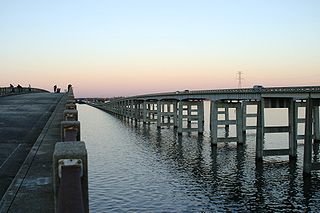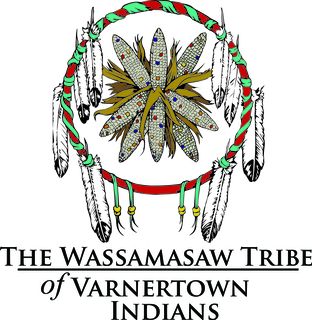
Orangeburg County is a county located in the U.S. state of South Carolina. As of the 2020 census, the population was 84,223. Its county seat is Orangeburg. The county was created in 1769.

The Santee River is a river in South Carolina in the United States, and is 143 miles (230 km) long. The Santee and its tributaries provide the principal drainage for the coastal areas of southeastern South Carolina and navigation for the central coastal plain of South Carolina, emptying into the Atlantic Ocean about halfway between Myrtle Beach and Charleston near the community of McClellanville. The farthest headwaters are 440 miles (708 km) away on the Catawba River in North Carolina. Besides the Catawba, other principal rivers of the Santee watershed include the Congaree, Broad, Linville, Saluda and the Wateree. The watershed drains a large portion of the Piedmont regions of South and North Carolina. The Santee River is the second largest river on the eastern coast of the United States, second only to the Susquehanna River in drainage area and flow. Much of the upper river is impounded by the expansive, horn-shaped Lake Marion reservoir, formed by the 8-mile (13 km)-long Santee Dam. The dam was built during the Great Depression of the 1930s as a Works Progress Administration (WPA) project to provide a major source of hydroelectric power for the state of South Carolina.

The Congaree River is a short but wide river in South Carolina in the United States; It flows for approximately 53 miles (85 km). The river serves an important role as the final outlet channel for the entire Lower Saluda and Lower Broad watersheds, before merging with the Wateree River just north of Lake Marion to form the Santee River.
The Waccamaw people were an Indigenous people of the Southeastern Woodlands, who lived in villages along the Waccamaw and Pee Dee rivers in North and South Carolina in the 18th century.
The Yamasee War was a conflict fought in South Carolina from 1715 to 1717 between British settlers from the Province of Carolina and the Yamasee, who were supported by a number of allied Native American peoples, including the Muscogee, Cherokee, Catawba, Apalachee, Apalachicola, Yuchi, Savannah River Shawnee, Congaree, Waxhaw, Pee Dee, Cape Fear, Cheraw, and others. Some of the Native American groups played a minor role, while others launched attacks throughout South Carolina in an attempt to destroy the colony.
The Yamasees were a multiethnic confederation of Native Americans who lived in the coastal region of present-day northern coastal Georgia near the Savannah River and later in northeastern Florida. The Yamasees engaged in revolts and wars with other native groups and Europeans living in North America, specifically from Florida to North Carolina.
The Winyaw were a Native American tribe living near Winyah Bay, Black River, and the lower course of the Pee Dee River in South Carolina. The Winyaw people disappeared as a distinct entity after 1720 and are thought to have merged with the Waccamaw.

The Pedee people, also Pee Dee and Peedee, were a historic Native American tribe of the Southeastern United States. Historically, their population has been concentrated in the Piedmont of present-day South Carolina. It is believed that in the 17th and 18th centuries, English colonists named the Pee Dee River and the Pee Dee region of South Carolina for the tribe. Today three state-recognized tribes, one state-recognized group, and several unrecognized groups claim descent from the historic Pedee people. Presently none of these organizations are recognized by the Bureau of Indian Affairs, with the Catawba Indian Nation being the only federally recognized tribe within South Carolina.

The Wassamasaw Tribe of Varnertown Indians or Wassamasaw Tribe is a state-recognized tribe and 501(c)(3) nonprofit organization headquartered in Berkeley County, South Carolina. The organization was awarded the status of a state-recognized tribe by the South Carolina Commission of Minority Affairs in November 2009, becoming the sixth state-recognized tribe within South Carolina. The Tribe is not federally recognized as a Native American tribe by the Bureau of Indian Affairs. The Catawba Indian Nation is the only Tribe in South Carolina that is federally recognized by the U.S. Government.

The Wateree River, about 75 mi (120 km) long, is a tributary of the Santee River in central South Carolina in the United States, which flows to the Atlantic Ocean. It was named for the Wateree Native Americans, a tribe who had migrated to this area from western North Carolina. They lived here until the early 18th century, when they were set upon and displaced by mostly English settlers during the Yamasee War. Survivors merged with the larger Catawba people, becoming extinct as a tribe.

Waccamaw Siouan Indians are one of eight state-recognized tribes in North Carolina. They are also known as the "People of the Fallen Star." Historically Siouan-speaking, they are located predominantly in the southeastern North Carolina counties of Bladen and Columbus. Their congressional representative introduced a failed bill for federal recognition in 1948. North Carolina recognized the group in 1971.

The Cheraw people, also known as the Saraw or Saura, were a Siouan-speaking tribe of Indigenous people of the Southeastern Woodlands, in the Piedmont area of North Carolina near the Sauratown Mountains, east of Pilot Mountain and north of the Yadkin River. They lived in villages near the Catawba River. Their first European and African contact was with the Hernando De Soto Expedition in 1540. The early explorer John Lawson included them in the larger eastern-Siouan confederacy, which he called "the Esaw Nation."
The Wateree were a Native American tribe in the interior of the present-day Carolinas. They probably belonged to the Siouan-Catawba language family. First encountered by the Spanish in 1567 in Western North Carolina, they migrated to the southeast and what developed as South Carolina by 1700, where English colonists noted them.
The Congaree were a historic group of Native Americans who once lived within what is now central South Carolina, along the Congaree River. They spoke a language distinct from and not mutually intelligible with other local Siouan languages. The language today is generally considered unclassified, though, some linguists believe that the language was related to Catawba. The tribe joined the Catawba Nation in company of the Wateree several years after temporarily migrating to the Waccamaw River in 1732. During the middle of the eighteenth century, Congaree was considered one of the languages spoken within the Catawba Nation.

The Cusabo or Cosabo were a group of American Indian tribes who lived along the coast of the Atlantic Ocean in what is now South Carolina, approximately between present-day Charleston and south to the Savannah River, at the time of European colonization. English colonists often referred to them as one of the Settlement Indians of South Carolina, tribes who "settled" among the colonists.
The Wando were a tribe of Native Americans of the Cusabo group who lived in South Carolina on the banks of the Cooper River.
The Sissipahaw or Haw were a Native American tribe of North Carolina. They are also variously recorded as Saxahapaw, Sauxpa, Sissipahaus, etc. Their settlements were generally located in the vicinity of modern-day Saxapahaw, North Carolina on the Haw River in Alamance County upstream from Cape Fear. They are possibly first recorded by the Spaniard Vendera in the 16th century as the Sauxpa in South Carolina. Their last mention in history is that the tribe joined the Yamasee against the English colonists in the Yamasee War of 1715. Some scholars speculate that they may have been a branch of the Shakori due to being so closely associated with that tribe but others disagree with this assumption.
Woccon was one of two Catawban languages of what is now the Eastern United States. Together with the Western Siouan languages, they formed the Siouan language family. It is attested only in a vocabulary of 143 words, printed in a 1709 compilation by English colonist John Lawson of Carolina. The Woccon people that Lawson encountered have been considered by scholars to have been a late subdivision of the Waccamaw.
The Ittiwan people, also spelled Etiwan, were a Native American tribe, who lived near present-day Goose Creek. Sometimes they were referred to as Summerville Indians. They were located approximately 30 miles northeast of Charleston, South Carolina. Members of the Wassamasaw Tribe of Varnertown Indians, a state-recognized tribe in South Carolina claim descent from Ittiwan among other groups.
Granby was the first European settlement in the area of present-day Columbia in the U.S. state of South Carolina. Settlement began around 1718 with the establishment of a trading post by the British on the Congaree River. Many small farms were settled by German, Swiss, and Scots-Irish immigrants. Granby was the largest town and county seat of Lexington County until the early 19th century, when the town began to gradually decline as Columbia, the state capital, grew. The once thriving colonial town was mostly unoccupied after the first quarter of the 19th century. Today, the area is part of present-day Cayce.









